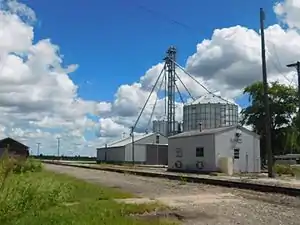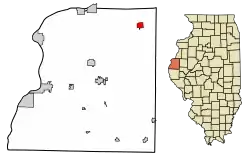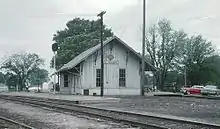La Harpe, Illinois
La Harpe is a city in Hancock County, Illinois, United States. The population was 1,235 at the 2010 census,[3] down from 1,385 at the 2000 census.
La Harpe, Illinois | |
|---|---|
 The former Toledo, Peoria and Western Railroad tracks through La Harpe | |
 Location of La Harpe in Hancock County, Illinois. | |
.svg.png.webp) Location of Illinois in the United States | |
| Coordinates: 40°34′59″N 90°58′8″W | |
| Country | United States |
| State | Illinois |
| County | Hancock |
| Area | |
| • Total | 1.36 sq mi (3.53 km2) |
| • Land | 1.36 sq mi (3.53 km2) |
| • Water | 0.00 sq mi (0.00 km2) |
| Population (2010) | |
| • Total | 1,235 |
| • Estimate (2019)[2] | 1,143 |
| • Density | 837.98/sq mi (323.66/km2) |
| Time zone | UTC-6 (CST) |
| • Summer (DST) | UTC-5 (CDT) |
| ZIP Code(s) | 61450 |
| Area code(s) | 217 |
| FIPS code | 17-40832 |
| Wikimedia Commons | La Harpe, Illinois |
| Website | cityoflaharpe |
Geography
La Harpe is located in northeastern Hancock County at 40°34′59″N 90°58′08″W,[4] south of the South Branch La Moine River. Illinois Route 9 passes through the city as its Main Street, leading east 25 miles (40 km) to Bushnell and west 13 miles (21 km) to Dallas City on the Mississippi River. Illinois Route 94 intersects IL 9 at the western edge of the city, and leads north 15 miles (24 km) to Stronghurst.
According to the 2010 census, La Harpe has a total area of 1.36 square miles (3.52 km2), all land.[5]
History
During the 18th century, French explorers headed by Bernard de la Harpe were forced to spend the winter just north of the present city of La Harpe. About 1896, four stone tablets dated June 15, 1715, and inscribed in French were reportedly found a few miles east of the old fortication built by the explorers. Stones were translated locally by the only French family in town as follows: "We are surrounded by indians and have no hope for survival unless help soon arrives." Said stone tablets were reported to be sent to the Smithsonian for authentication, and were ruled a hoax. Their whereabouts are currently unknown.
Soon after 1830, landowners in the area began to develop a town which they called "Franklin". In 1836, they applied for a post office and were informed another town in Illinois was already named Franklin. The first postmaster, Louis Rice Chaffin, suggested the name be registered as "La Harpe", for the Frenchman who spent the winter over 100 years earlier. The City of La Harpe was granted a charter by the Illinois legislature in 1859. The charter was amended in 1861 to change the size of the town, and the boundaries have changed through the years. Today the city has 22 streets and avenues.

In 1867, the TP&W railroad line was completed through the town. In 1888, the city council bought the first fire engine, but a fire in October 1893 still destroyed nearly all the businesses in one block of Main Street. City Hall was built in 1894. The election of 1895 was the first election in which the women of La Harpe were allowed to vote on the issue of liquor licenses. (The women had a separate ballot box.) The La Harpe Carnegie Public Library was built in 1905, with local support and a donation from Andrew Carnegie. Today it is listed on the National Register of Historic Sites. The City Park was donated by Marvin Tyron, one of the town's founders, as a public square.
In 1986, La Harpe celebrated 150 years of history. During that year, a sesquicentennial history entitled La Harpe, Illinois, 1836-1986 was published.
Each summer the town used to celebrate their Summerfest on the town square. The annual Fred Gibb Car Show is held in August. Gibb's claim to fame was as the sponsor of the original ZL-1 COPO Camaros and Novas during the pony car era of the early 1970s. Gibb's name has since been omitted from the car show.
Today, many of the surviving buildings in La Harpe's business districts, including the City Hall, are on the National Register of Historic Places. La Harpe had the only four-story building in Hancock County. The park district includes a community clubhouse, swimming pool, the LaMoine Valley golf course, and a complex of lighted ball fields. The city park has a lighted shelter house and stage.
Schools
Illini West High School
- Home of the Chargers
In August 2007, La Harpe High School, as well as Dallas City and Carthage High Schools, were deactivated through the first school convergence to be approved by voters in the state of Illinois, with much regret. Former La Harpe students are now attending the newly formed Illini West High School in Carthage, Illinois.
La Harpe Grade School/Jr. High
The La Harpe Community School District #347 was formed with the dissolution of District #335. The former High School facility was renovated extensively.
La Harpe Elementary was recently named an Illinois Spotlight School. A Spotlight School is a high poverty school where academic performance is closing the "achievement gap".[6]
La Harpe High School
- Former home of the Eagles/Thunder/Cyclones
In 1996, the Northwestern-La Harpe Thunder football team was the first athletic team with La Harpe High School students to ever participate in the IHSA State Finals. They were defeated 35-28 by the Chenoa Redbirds. In 2000, the team once again made it to the IHSA State Finals and were defeated by the Carthage Blueboys 14–0.
In 1839, a log cabin was built to be used as a blacksmith shop. After a few years it became the first school house in La Harpe. The log cabin served as a school house until 1844, when it was sold and became a blacksmith shop again. The next school building was a brick building that had an enrollment of 98 students. This building served as a public school until the academy was built in 1857. The Academy was located on the present site of the elementary school building. A new building was built in 1898 for a larger student body. This building served as the high school and elementary school until it was destroyed by fire in 1927. A new structure was built in 1929. This building was in use until 2012 when it was dismantled in anticipation of grant funding for a new school from the State of Illinois, which never materialized. The school became La Harpe Community School District on April 20, 1942. In 1958, the current high school building was built. On May 2, 1961, the former La Harpe Community School District #335 was formed from the communities of Fountain Green, Terre Haute, La Harpe, and Durham. On May 27, 2007, the high school hosted its final graduation.
Park District
- Lamoine Valley Golf Club
- LaHarpe Community Swimming Pool
Notable people
- Harold Arlin, radio's first salaried announcer, born in La Harpe[7]
- Charles Duryea, co-invented first gasoline-powered automobile, graduated from La Harpe's Gittings Seminary (1882)
- Olive Oatman, pioneer Mormon teenager abducted by Native Americans who marked her with a chin tattoo. (1851)
- Olan Soule, actor, born in La Harpe[8]
Demographics
| Historical population | |||
|---|---|---|---|
| Census | Pop. | %± | |
| 1880 | 958 | — | |
| 1890 | 1,113 | 16.2% | |
| 1900 | 1,591 | 42.9% | |
| 1910 | 1,349 | −15.2% | |
| 1920 | 1,323 | −1.9% | |
| 1930 | 1,175 | −11.2% | |
| 1940 | 1,322 | 12.5% | |
| 1950 | 1,295 | −2.0% | |
| 1960 | 1,322 | 2.1% | |
| 1970 | 1,240 | −6.2% | |
| 1980 | 1,471 | 18.6% | |
| 1990 | 1,407 | −4.4% | |
| 2000 | 1,385 | −1.6% | |
| 2010 | 1,235 | −10.8% | |
| 2019 (est.) | 1,143 | [2] | −7.4% |
| U.S. Decennial Census[9] | |||
As of the census[10] of 2000, there were 1,385 people, 561 households, and 383 families residing in the city. The population density was 1,021.8 people per square mile (393.2/km2). There were 604 housing units at an average density of 445.6 per square mile (171.5/km2). The racial makeup of the city was 99.78% White, 0.07% from other races, and 0.14% from two or more races. Hispanic or Latino of any race were 0.14% of the population.
There were 561 households, out of which 31.2% had children under the age of 18 living with them, 57.0% were married couples living together, 9.4% had a female householder with no husband present, and 31.6% were non-families. 29.1% of all households were made up of individuals, and 16.0% had someone living alone who was 65 years of age or older. The average household size was 2.39 and the average family size was 2.93.
In the city, the population was spread out, with 24.0% under the age of 18, 6.5% from 18 to 24, 24.4% from 25 to 44, 23.5% from 45 to 64, and 21.7% who were 65 years of age or older. The median age was 41 years. For every 100 females, there were 85.2 males. For every 100 females age 18 and over, there were 77.3 males.
The median income for a household in the city was $32,589, and the median income for a family was $37,708. Males had a median income of $31,250 versus $20,400 for females. The per capita income for the city was $15,586. About 4.6% of families and 7.4% of the population were below the poverty line, including 8.9% of those under age 18 and 6.3% of those age 65 or over.
References
- "2019 U.S. Gazetteer Files". United States Census Bureau. Retrieved July 14, 2020.
- "Population and Housing Unit Estimates". United States Census Bureau. May 24, 2020. Retrieved May 27, 2020.
- "Geographic Identifiers: 2010 Demographic Profile Data (G001): La Harpe city, Illinois". American Factfinder. U.S. Census Bureau. Retrieved June 9, 2017.
- "US Gazetteer files: 2010, 2000, and 1990". United States Census Bureau. 2011-02-12. Retrieved 2011-04-23.
- "G001 - Geographic Identifiers - 2010 Census Summary File 1". United States Census Bureau. Archived from the original on 2020-02-13. Retrieved 2015-12-27.
- http://www.laharpeeagles.org/vnews/display.v/ART/4f5469aeb4a32
- Ham, Eldon L. (2011). Broadcasting Baseball: A History of the National Pastime on Radio and Television. McFarland. p. 26. ISBN 978-0-786-48635-9. Retrieved June 21, 2016.
- Dunning, John. On the Air: The Encyclopedia of Old-Time Radio. Oxford University Press, 1998; ISBN 0-19-507678-8
- "Census of Population and Housing". Census.gov. Retrieved June 4, 2015.
- "U.S. Census website". United States Census Bureau. Retrieved 2008-01-31.
External links
- City of La Harpe
- La Harpe Carnegie Public Library
- La Harpe Grade/Jr. High School
- Illini West High School
- Hancock County Quill, local newspaper
- Hancock County Journal Pilot, local newspaper